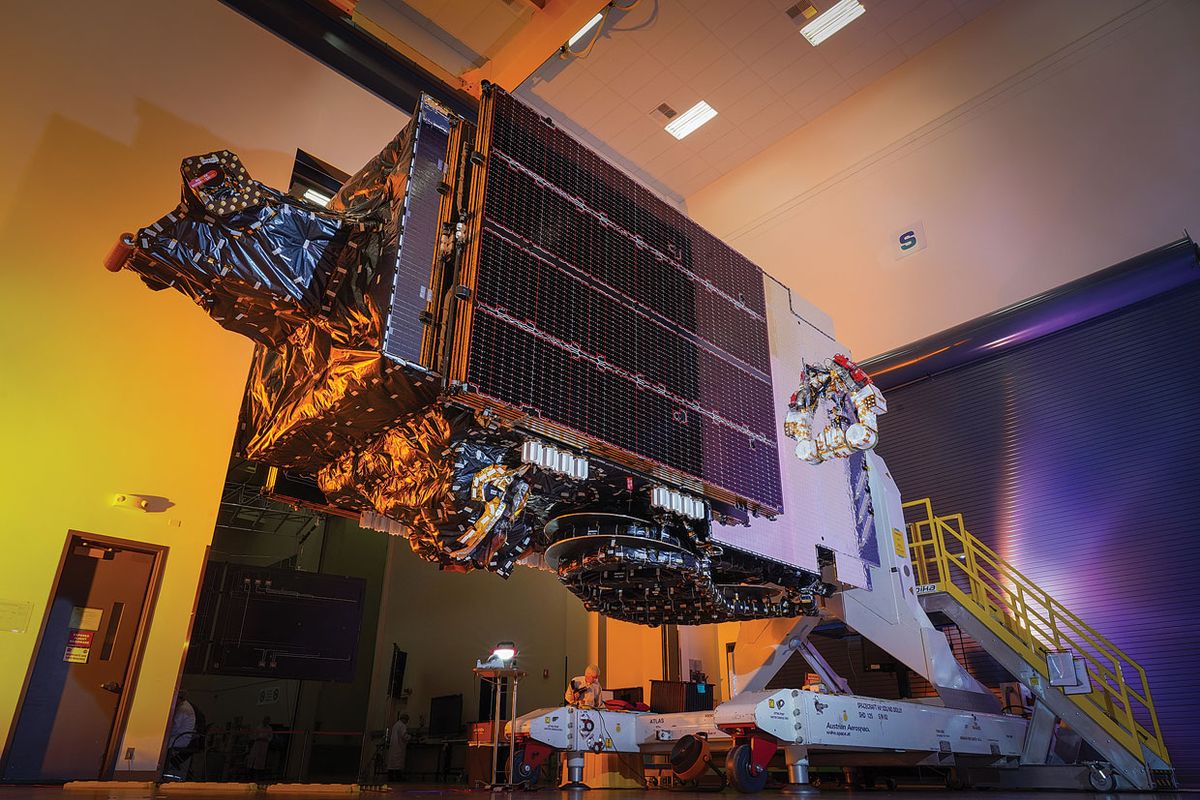Over the past few months, the spacecraft manufacturing company SSL put the finishing touches on three massive communications satellites. It built two of them for Canadian operator Telesat. Then it initiated its plan to have them launched, one after the other, into distinct geosynchronous orbits 36,000 kilometers above Earth—perches that will keep each satellite hovering over a particular spot, even as the planet turns.
From their respective vantage points, the pair built for Telesat will deliver high-speed communications services, including broadband Internet, to Asia and the Americas for the next 15 years.
At more than 7,000 kilograms, Telstar 19 Vantage became the heaviest commercial communications satellite ever launched when it left Earth on 22 July. But the record-setting 19V and its sibling, Telstar 18 Vantage (which was launched on 10 September), are also noteworthy in other ways.
What makes them so special? The 18V and 19V feature antennas that can transmit a type of beam that will vastly improve their data throughput. What’s more, SSL used 3D-printing techniques to build and customize both satellites.
Geosynchronous communications satellites send and receive signals over an exceptionally wide coverage area. “With geo, you can cover about one-third of the Earth with one satellite,” says Carolyn Belle, a senior analyst at Northern Sky Research, in Cambridge, Mass., a telecommunications consulting firm. From certain angles, these satellites can have almost half of the global population within range.

That’s a lot of potential users, spread over a massive area, which is why communications satellites have historically operated with wide-beam coverage. But, as SSL’s acting chief technology officer Rob Schwarz says, spot beams are becoming more popular. Spot beams are focused rays of electromagnetic energy that can transmit more data to smaller areas than wide beams can manage.
“An analogy is the human eye and the insect compound eye,” says Schwarz. “The human eye is one wide view, while the compound eye is like spot beams.” Like the components of the multifaceted eye of a dragonfly, the spot beams produced by antennas onboard both the 18V and 19V focus in slightly different directions, allowing the same spectrum bands to be used multiple times without interference.
Eventually, the 18V and 19V will look down on Earth with their spot beams and wide beams, as if through a compound contact lens fitted over an eye. “There will be a backdrop of broad-area beams, and in high-density areas, we’re adding spot beams to aid coverage,” says Schwarz.
Spot beams ultimately function similarly to cell towers. The satellite transmits along a specific band in the general area around the ground station, and the station, tuned into that band, will receive the signal. “It’s like locating a cellphone in a specific cell,” says Schwarz.

The 18V and 19V use the Ku (12 to 18 gigahertz) and Ka (26 to 40 GHz) bands for their spot beams and wide beams. The bands have risen in popularity in recent years because they deliver higher data rates than the 4-to-8-GHz C band commonly used for satellite communications. This shift came despite the fact that higher-frequency bands have a greater signal loss in the atmosphere, particularly in rainy climates.
Both of SSL’s new communications satellites—and a third called Merah Putih (launched 7 August) that SSL built for the state-owned operator Telkom Indonesia—are based on the popular SSL 1300 series framework. Additionally, the satellites required specialized antenna arrays, which in Telesat’s case had to support spot beams.
The Telstar satellites launched by SSL, which is based in Palo Alto, Calif., have 3D-printed components in the antenna struts, which support antennas, tracking equipment, and satellite-control equipment. The 3D printing speeds up the design process and can create joints that are just as strong but have more complex shapes than those made with traditional assembly, without requiring difficult welding.

This technique also cuts down on costs, though geosynchronous satellites remain expensive. “Geosatellites are up in the billions of dollars per satellite” after factoring in the cost of launching, says analyst Belle. Although some startups are pursuing constellations of smaller, low-Earth-orbit satellites as an alternative, Belle says larger satellites remain viable thanks to their efficient power usage and very low cost per bit of data.
As for the trio of new communications satellites, each one must spend about 10 days under its own propulsion after launch to reach its final, geosynchronous orbit. Once there, they deploy their solar arrays and open their antennas. As SSL makes contact with each satellite, it runs checks on every system to ensure the equipment is in optimal condition. Then SSL shepherds the satellites for 30 to 40 days before handing them over to their operators.
If they do their jobs well for the next 15 years, then just before each satellite runs out of propellant, it will be boosted into a higher, graveyard orbit. “The graveyard orbit is for the good satellites who have completed their operations,” says Schwarz.
This article appears in the October 2018 print issue as “New Spot Beams Boost Satellites’ Bandwidth.”
